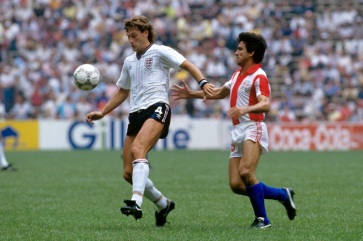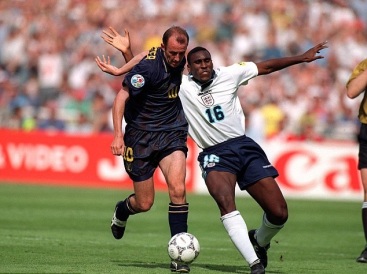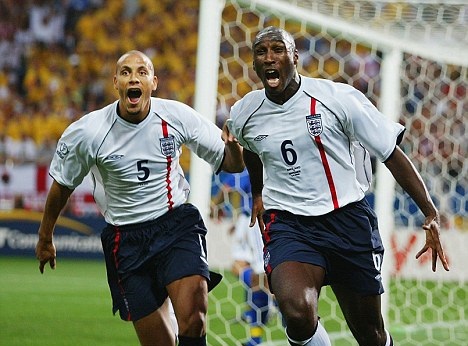Every Wednesday, we like to read The Knowledge in The Guardian. The questions are often fascinating, the answers often moreso, and every once in a while there is a query which is right up our alley:
Unfortunately, our reply to The Knowledge wasn’t in time for their deadline, but you can still enjoy/endure the long answer.
Further direct contact with Alex revealed him to have been wondering who wore the most different numbers in any senior internationals, but we took it to mean major finals, i.e. competitions where set squad numbers were assigned (and ignoring the 1993 US Cup, 1995 Umbro Cup and 1997 Tournoi de France).
We will time try to come up with a definitive answer but for now the major finals provide enough material anyway. The 1954 World Cup was the first to utilise squad numbers and, since then, there have been 465 places up for grabs. A total of 87 players have worn two numbers, 16 have worn three and just two have been allocated four different numbers. There is one man, though, who has had five.
We won’t go through all of the three-number players, but there are some notable instances. Bobby Charlton was given 20 for his World Cup in 1958, four years later he wore 11 and by 1966 of course he had 9, which he retained for 1970.
Peter Shilton’s wearing of 1 at the 1986 World Cup was the first time he had been given it for a finals, having worn 13 at Euro 80 and then 22 for Spain 82. He played once in 1980 and in all of the games in ’82, but England’s numbering was alphabetical, of a kind. Captain Kevin Keegan was allowed to retain 7 with all of the other outfielders arranged by surname. Though the goalkeepers were the usual 1, 13 and 22, Ray Clemence, Joe Corrigan and Shilton were sorted alphabetically too.
The ’86 World Cup also saw Ray Wilkins in a third consecutive different number, wearing 4 after the ’82 system had him 19. What’s most noteworthy is that he wore 6 at Euro 80 – most un-English for a midfielder – presumably Phil Thompson was keen to keep 4, which he had at Liverpool.
Chris Waddles wore 11 in Mexico, 12 at Euro 88 and 8 at Italia 90. David James is the other goalkeeper to have had three numbers, going 22-1-13 from 2002-06 while James Milner has gone 16-17-4 across the last three tournaments.
Onto the four-timers, though, with Glenn Hoddle the first to achieve it. In 1980, he was handed ‘Gazza’s number 19‘ ten years before Gazza (no picture unfortunately as he only played against Spain and the shorts didn’t have numbers), and then in 1982 the alphabetical system meant he wore 9.

It could nearly be argued, though, that 9 was a more suitable fit for an attacking midfielder than the 4 he wore in ’86.

The very short shorts of the 1980s, coupled with Hoddle’s preference for wearing his shirt untucked, mean that there is no good pictorial evidence from Euro 88, but he was 17 this time around.
The next time England rocked up at the Euros, Martin Keown was wearing the number 4 shirt.

While he wasn’t part of the squad for Euro 96, he was included for World Cup 98 after helping Arsenal to the double but his number 18 didn’t see any game-time. He was first choice for Euro 2000, this time wearing 6 (in a switcheroo with Tony Adams, who wore it for Arsenal while Keown had 5).

By the time of 2002 World Cup, he was just a squad member again and once more was left on the sidelines, but this time wearing 15. He is one of only three Englishmmen to go to two World Cups and not play at all, and coincidentally the other two – George Eastham (1962 and ’66) and Viv Anderson (1982 and ’86) – were Arsenal players as well.
When Keown won his second double with Arsenal in ’02, Sol Campbell was his most regular partner and the former Tottenham man holds the distinction of wearing five different numbers across six tournaments. Coincidentally, he was the answer on one of our previous Knowledge appearances too.
As a greenhorn at Euro 96, his only action was as a late sub against Scotland, wearing 16.

A first-choice for France 98, Glenn Hoddle’s 3-5-2 system meant that the numbering had to be tweaked slightly. Graeme Le Saux retained 3 as the left wing-back, so that meant that Campbell had 2 as he joined the 5 and 6, Adams and Gareth Southgate, in central defence. Here he is not scoring a legitimate goal against Argentina.

With Adams and Keown 5 and 6 at Euro 2000, Campbell was perhaps surprisingly given 4, Paul Ince shunted to 14. He and Adams started together in the game against Portugal, with Ince the only player over 11 in the line-up and 6 absent.

For the 2002 World Cup, Campbell would finally receive one of the ‘proper’ centre-back numbers, given 6 as Rio Ferdinand wore 5, and he retained it for Euro 2004 too.

By 2006, though, John Terry had usurped him and, by and large, Sven-Goran Eriksson’s squad numbering was reflective of the first 11 (at Euro 2004, England began three of the four games wearing 1-11). As a result, Campbell was given 12.

Will such an achievement be matched? Of the Euro 2016 squad, only the aforementioned Milner has had three numbers and he’s 30 now so it’s unlikely (Edit: As pointed out in the comments, he has retired too, which is another impediment). Jack Wilshere (7 in 2012, 17 in 2016) or Ross Barkley (21 in 2014, 19 in 2016) perhaps, but it’s almost certain that Campbell won’t be passed out.
At the other end of the spectrum, David Seaman (1), Ashley Cole (3) and David Beckham (7) wore the same number at five tournaments. This year’s European Championship was Wayne Rooney’s sixth finals, but he wore 9 in his first two, 2004 and 2006, before switching to 10.
One final thing of note – for the 2006 World Cup, Fabio Capello opted to go with the Italian tradition of giving a goalkeeper 12 rather than 13, meaning that Stephen Warnock was the first England outfielder to be allocated the number at a finals since Derek Kevan in 1962, but apparently the latter didn’t even travel.
Reserve goalkeepers Eddie Hopkinson and Alan Hodgkinson were 12 and 13 respectively for the 1958 World Cup (though, again, Hodgkinson was a stay-at-home reserve), so 1954 squad member Ken Green is the only outfielder apart from Warnock to actually wear 13 at a finals.










































